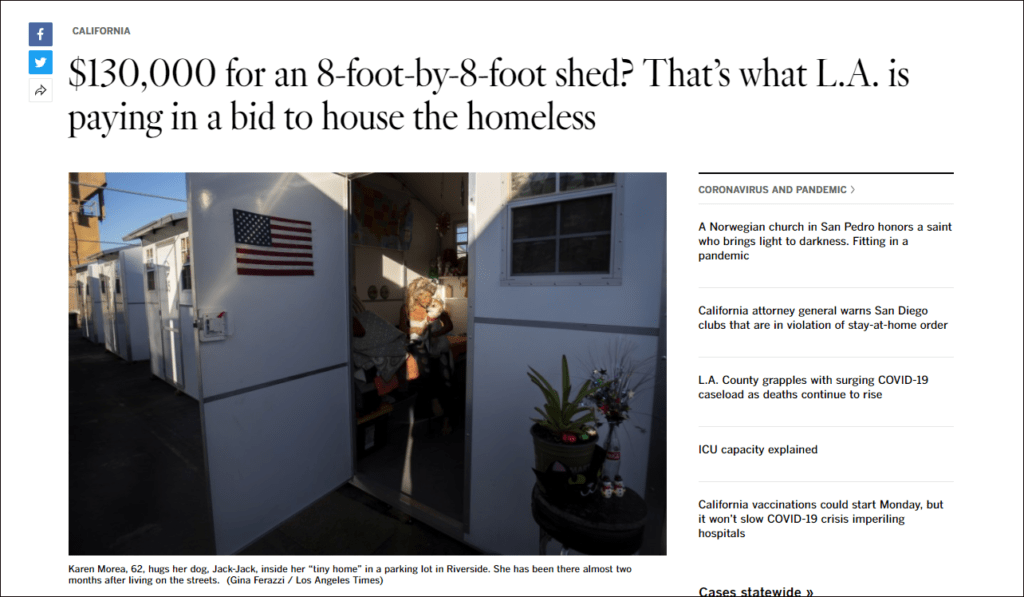It is about 2.6 meters long, 2.3 meters wide, and has a total area of 5.98 square meters. It is composed of an aluminum frame and composite panels.
The two retractable beds in the house are the only furniture; There are no separate showers and toilets in the whole house, and sanitary equipment needs to be shared with strangers…
If you were a homeless person in the United States, would you be tempted by the “small shelter” provided by the local government? But what if someone tells you that such a “tiny home” costs 130,000 US dollars each?
According to the “Los Angeles Times” report on the 12th, the above-mentioned absurd scene occurred in Los Angeles, USA.
In January next year, the first simple community “small house” project in Los Angeles will welcome the first batch of homeless people.
However, the jaw-dropping cost of the city government aroused public outrage.
Currently, the Los Angeles Legal Aid Foundation has filed a lawsuit with the city government on behalf of the homeless.
At this “box” about the size of a cell, lawyer Shayla Myers scolded: “How can two adults with their own lives share this space reasonably? It’s almost unimaginable!”

Compared with other major cities in the United States, the housing security project in Los Angeles is not only late, but also because of its high cost.
In March of this year, Los Angeles Mayor Eric Garcetti announced that the city’s “small house” plan for the homeless would be completed in stages: in January next year, the first batch of 39 “clothes” “Cabinet-sized” houses will be used for external use; the other five security communities set up around the city will also be opened one after another.
The Los Angeles Times believes that this move shows that the concept of “allowing people to live in small houses”, which has long been ignored in Los Angeles, has become a major strategy for the city in responding to federal lawsuits.
Previously, the federal government had criticized the city of Los Angeles for doing little to help the homeless.
But things went contrary to expectations.
The plan was not only difficult to complete the tasks assigned by the federal government, but also caused public grievances because of the high cost.
The cost of less than 6 square meters was as high as 130,000 US dollars.
In response to the public’s criticisms, the Los Angeles city government officials were aggrieved.
The city council official Mike Feuer said it was “very unfair” to evaluate the matter only by housing costs.
Foer argued that the city of Los Angeles has done everything it can to reduce costs, “but not at the expense of safety and health, or higher overall costs.”
He further explained that the cost of the house itself only accounts for a small part of the total cost, and that the cost of the site and infrastructure is the “big head”.
According to the information given by Fuer, the breakdown of the costs are: 1.5 million USD for the venue, 122,000 USD for underground utilities, 253,000 USD for the concrete cushion (one per house), 312,000 for the administrative office and the staff lounge. US dollars, 1.1 million US dollars for mechanical and electrical and fire alarms, 280,000 US dollars for permits and fees, 651,000 US dollars for street sewage pipe connections, and 546,000 US dollars for design, project management and inspection costs.
But it is clear that the defense of the city government officials is not convincing, especially when compared with other cities.
In January of this year, the Sonoma County government in California opened a security community similar to Los Angeles. Each “small house” cost only US$21,817
In March of this year, Riverside, California, spent US$512,000 to build the city’s first batch of guaranteed communities, and the cost of each “small house” was only slightly more than US$17,000.
Tacoma, Washington, has also recently purchased 58 simple houses, which cost a total of 700,000 US dollars to build protected communities, and the cost of each house is only 12,000 US dollars.
Currently, the Los Angeles Legal Aid Foundation has filed a lawsuit against the Los Angeles City Government on behalf of the homeless. Lawyer Myers (Shayla Myers) scolded: “How can two adults with their own lives share this space reasonably? It is almost unimaginable!”
Elizabeth A. Mitchell, a lawyer for the Los Angeles Human Rights League, was also very angry.
She said: “This is an example of why our Los Angeles is in chaos. They (the city government) do these costly projects and only provide beds for a few people, while others are humiliated on the street.”



